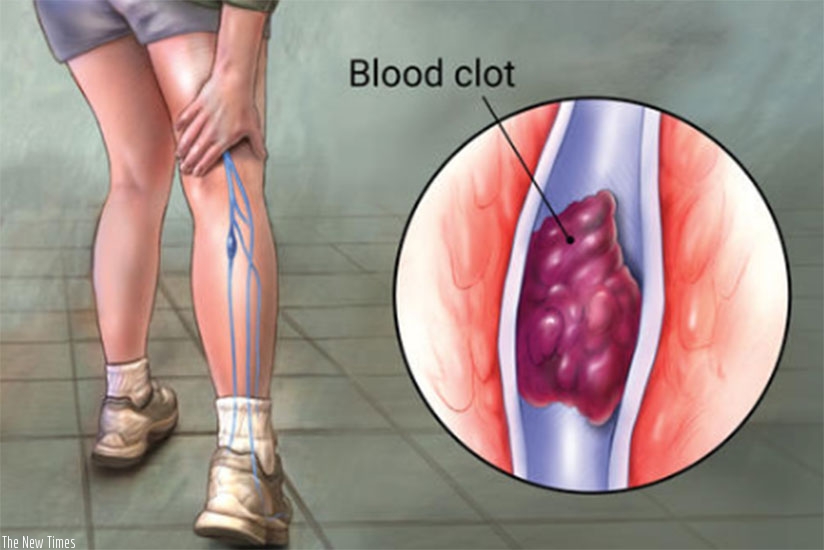Deep vein thrombosis is a fairly uncommon ailment, but nonetheless very dangerous to one’s health. The condition is mostly as a result of an imbalance of blood coagulation (the action of a liquid especially blood, changing to a solid or semi-solid state).


Deep vein thrombosis is a fairly uncommon ailment, but nonetheless very dangerous to one’s health. The condition is mostly as a result of an imbalance of blood coagulation (the action of a liquid especially blood, changing to a solid or semi-solid state).
On 13th October, the world will celebrate World Thrombosis Day aimed at improving awareness about the condition and strengthen the fight against it.
Christine Ashimwe, a survivor and founder of Rwanda Clot Awareness Network (R-CAN), a local network aimed at fighting this condition, says their goal is to increase public awareness of thrombosis and, ultimately reduce deaths and disabilities from thromboembolic disease.
This, she hopes to achieve through a greater awareness of the causes, risk factors, signs and symptoms, and evidence-based prevention and treatment measures of the condition.
"As a survivor, I think people need to know the causes, risk factors, signs and symptoms. With this, they will be able to tell when they see someone struggling to catch their breath for example with pulmonary embolism or struggling to walk on their swollen leg for example with deep vein thrombosis,” she says.
Ashimwe believes that doing more research on this condition is crucial in prevention efforts and treatment.
"I am conducting research on why information about blood clots during pregnancy is not included in the antenatal package in Rwanda and how this can be changed, education is so important,” she says.
She says as an organisation they will carry out an awareness campaign at King Faisal Hospital on October 14 as part of activities to mark World Thrombosis Day.
"We shall also visit hospitalised patients suffering from this condition and offer them different support, for example, providing them with the anticoagulants because medicines are very expensive,” Ashimwe says.
Possible causes of this condition
Medics explain that for the blood to have its fluidity there has to be a balance between bleeding and clotting. If there is a lack in protein or factors controlling the clotting, that’s when the clot formation occurs.
Thrombosis refers to abnormal, life-threatening blood clots that form in the artery or vein and this can happen in the leg, lungs, brain among other parts.
Lt Col Dr Fabien Ntaganda, a hemato-pathologist at Rwanda Military Hospital, explains that some of the causes of thrombosis or deep vein thrombosis are classified into two major categories.
One is acquired by causes like cancer, contraceptive pills, HIV, obesity, immobility and advanced age and the second one involves inherited causes including deficiency mainly in protein c, protein s, anti-thrombin III, and Factor V leiden.
Dr Evariste Ntaganda, the head of the non-communicable diseases division at the Rwanda Biomedical Centre, says the condition involves local coagulation or clotting of the blood in a part of the circulatory system.
He points out that a thrombus is a blood clot in the vascular system (circulatory system) which stays attached to the site where it was formed and impedes blood flow. Under these circumstances, a person is said to be experiencing a thrombosis.
A thrombus, he says, is more likely to occur in people who are immobile and who are genetically predisposed to blood clotting. A thrombus can also form if an artery, vein, or surrounding tissue is damaged.
Ntaganda adds that thrombus occurs when a blood clot remains and circulates in the vascular system. It may reach vital organs and prevent blood vessels from functioning correctly.
"Clotting is caused by chemical reactions between blood cells (platelets) and proteins (clotting factors). A healthy body regulates the clotting process as the body needs it. When any of the following factors are present, a clot can form more easily within a blood vessel. Tobacco smoking, high cholesterol, diabetes mellitus and stress are among other risk factors,” he says.
Ntaganda is of the view that some of these factors also increase the risk of atherosclerosis, a condition where the blood vessels become clogged with fatty plaque deposits.
Atherosclerosis on the other hand increases the risk of blood clots blocking the arteries, as well as the veins.
"Arterial and venous thrombosis can reduce or totally prevent blood flow. This can lead to severe and even life-threatening complications, depending on where the thrombus forms. A thrombus does not usually cause any symptoms until it blocks or heavily restricts the flow of blood,” he adds.
Are you at risk?
Ntaganda explains that for one to know that they have this condition, signs and symptoms are usually observed in that specific part where the clot is.
"When the clot formation happens in the lower limbs, it affects one leg unilaterally and the leg is swollen and painful when walking. When the clot affects the lungs, it is a medical emergency characterised by shortness of breath and if not attended to quickly death occurs in 80 per cent of cases,” he warns.
Ntaganda adds that when the clot affects the brain, the patient presents with stroke and a loss of function in one or more parts of the body.
When the clot occurs in the abdomen (thrombosis of unusual site) it is due to a disease called paroxysmal nocturnal hemoglobunuria, it is characterised by dark urine in the morning due to intravascular hemolysis, he says.
Research done by University of Michigan Health System indicates that deep vein thrombosis occurs when a blood clot forms in the large veins of the legs or pelvic region, and that if the clot breaks loose and travels to the lungs, a pulmonary embolism may result. Pulmonary embolism is a blockage in one of the pulmonary arteries in your lungs.
"Anyone can develop deep vein thrombosis; however, the more risk factors you have, the greater your chances of developing the condition. Hospitalised patients are at a high risk for deep vein thrombosis and pulmonary embolism, with risk factors varying depending on the reason for the hospitalization, the seriousness of the illness and any surgery that was performed. For example, hip- replacement patients may develop a deep vein thrombosis or pulmonary embolism if they fail to receive appropriate preventive therapy,” the research shows.
Advanced age, active cancer and cancer treatments, Immobility, paralysis, recent trauma, surgery or hospitalisation are some of the risk factors showed in the research.
Family history or personal history of deep vein thrombosis, chronic medical conditions, infections, inherited and acquired blood clotting abnormalities are some of the other risk factors.
Treatment
Dr Evariste is of the view that the aim of thrombus treatment is to effectively control symptoms, restore blood flow and reduce or remove the thrombus.
When it comes to treating thrombosis, he says the use of compression stockings is helpful.
"It can be recommended that people wear compression stockings while taking anticoagulant therapy for deep vein thrombosis (DVTs.). The stockings help to prevent calf pain and swelling, and they reduce the risk of complications,” he says.
Dr Evariste also says a person should wear compression stockings during the day for as long as their doctor recommend.
He also mentions surgery as another option for treating deep vein thrombosis.
"Surgery for the effects of thrombosis will always be a medical emergency. It can involve directly accessing and unblocking an affected artery. In other cases, blood flow will be diverted or will completely bypass the blocked artery,” he explains.
Ntaganda points out that treatment in most cases is done with medication called blood thinner like Warfarin which targets Vitamin K dependent factors. Warfarin has many side effects and a big number of interference.
He says currently it is not a recommended medication as it interferes with everything under the sun.
"We use a class of medications called direct oral anticoagulants (DOAC). This medication does not have many side effects and regular monitoring and target a single factor whether factor Xa or factor II. Surgical means can also be applied using Inferior Vena Cava filters that remove the clots,” he says.
Ntaganda, however, notes that as with any infirmity, preventive measures are necessary when it comes to dealing with thrombosis especially in patients at high risk for instance during pregnancy and in post-surgery and cancer patients.
"Hypercoagulable state of thrombosis is a reality in Rwanda. The majority of patients come from obstetrics and gynecology. To avoid these cases, preventive measures during pregnancy and in post-partum should be observed strictly,” he notes.
People should use all measures to prevent DVT by losing weight if one is over weighted, exercise regularly and stay active, avoid standing for a long period and contraceptive pills, Ntaganda advises.


